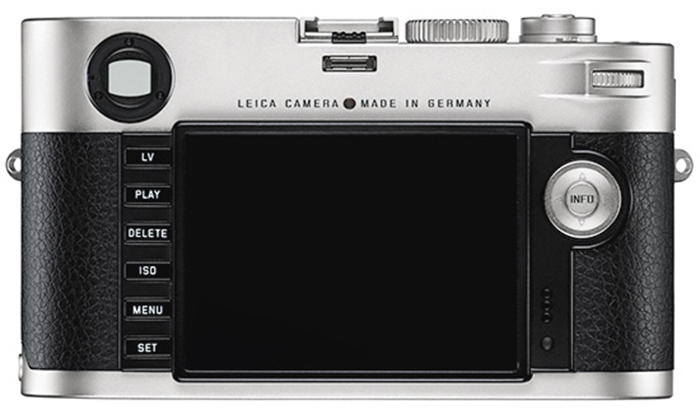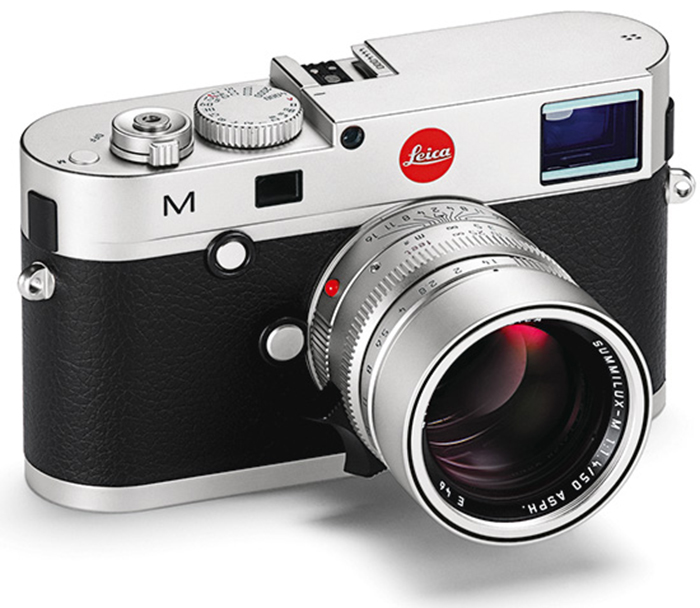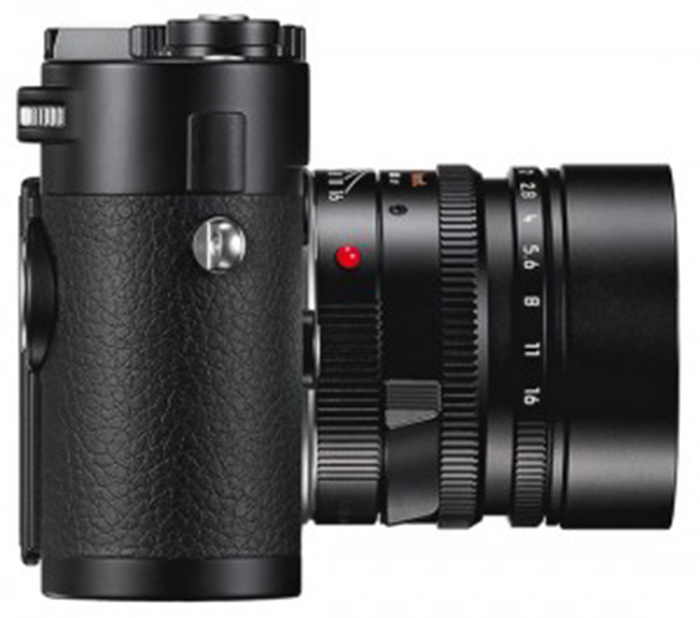Today Leica announced a ton of new toys. One of them was simply called the Leica M. Leica said they took care of all the M9 problems and put everything in one nice package for $6,950, which is the same price as the M9 when it was released. The Leica M is now available to pre-order in black and silver.
Press release:
The perfection of digital rangefinder technology
Solms, Germany (September 17, 2012) - Leica Camera presents a groundbreaking milestone in the nearly 60 year history of the Leica rangefinder system: The Leica M. Setting entirely new standards, the Leica M unites the ultimate in rangefinder precision with cutting edge digital technology. As the first camera to implement a newly designed CMOS image sensor and to feature additional focusing methods and functions such as Live View and Full HD video capability, it is the most versatile Leica rangefinder model ever. Remaining true to the legendary values of the M-System, the Leica M not only provides the advantages of rangefinder photography, but also for the first time, offers compatibility with Leica R legacy lenses. As with every innovation and development since the flagship line’s inception, the Leica M was created to capture fleeting moments of time and transform them into living history.









The Leica M also marks the beginning of a new era in the Leica product naming policy. In future, Leica M and S model names will omit the number suffix to emphasize the enduring and long-term significance of the respective systems.
In every respect, the new Leica M is the most innovative and versatile model the modern M-System has ever created. Looking to the future, the Leica M is the first in a long line of Leica rangefinder cameras to feature a completely new development in sensor technology; the Leica Max CMOS image sensor. This 24 MP, full 35 mm format sensor was designed and constructed in collaboration with CMOSIS especially for the camera and its use with M- and R-Lenses. This new development successfully transfers the characteristic advantages of CCD sensors, such as natural and brilliant color rendition and impressive reproduction of details, to a CMOS sensor.
In combination with the high-performance Leica Maestro processor that is also employed in Leica S cameras, this new full format sensor guarantees maximum imaging quality and speed. Now, all elements in the image creation chain, from the lens to the image file, are under complete control of the Leica engineers. This guarantees the ultimate in imaging performance and quality. An additional highlight is the low power consumption of the components that, in conjunction with the particularly high capacity of the battery, ensures outstanding performance over a long period of use.
In 1954, the launch of the M-System opened new horizons in reportage and artistic photography. Now at the dawn of a new era in the system’s technology, the Leica M offers a multitude of new features. The first of these are Live View and Live View Focus. Image composition can now take place in real time with the view of the subject through the lens. The sharpness, exposure and color content of images can now be precisely assessed on the camera’s large, 3-inch, high-resolution monitor screen with 920,000 pixels. The glass covering plate of the monitor screen is manufactured from particularly tough and scratch-resistant Corning®Gorilla®Glass. The new Live View function allows photographers to have access to entirely new opportunities that, in combination with the outstanding performance of Leica M- and R-Lenses, go far beyond the classical capabilities of rangefinder photography. This applies particularly to macro and telephoto photography, but also allows even more discreet shooting. In combination with M- and R-Lenses, the camera’s new 1080p Full HD video capability also opens up further opportunities to record memories as they happen.
Ever in pursuit of capturing Henri Cartier-Bresson’s “Decisive Moment,” the Leica M offers two additional focusing methods that can be activated quickly and easily with the new focus button. M-Photographers now have even more options for capturing outstandingly sharp images. The new ‘Live View Zoom’ option enables up to 10 x magnification for precise assessment of the sharpness of subject details or the close focusing limit. The second aid to focusing is ‘Live View Focus Peaking’. Here, contours in the subject are automatically displayed as red lines to allow simple and convenient focus assessment. Focusing precision can be assessed on the basis of the intensity of the lines displayed.
The Leica M’s features are optimally combined with the typical values of the Leica rangefinder system and guarantee the accustomed dependability of the Leica M in all photographic situations, from available light photography to discreet and aesthetic fine-art image composition. In line with the principles of the M-Philosophy, all functions and features are designed and constructed for absolute robustness and a long working life. The top deck and the base plate of the Leica M are machined from solid brass blanks and the full-metal chassis is a completely self-contained diecast element manufactured from high-strength magnesium alloy. Special rubber seals protect the camera body against dust, spray and moisture.
The new rangefinder camera is also a typical M due to its intuitive handling concept with direct manual setting options and fast access to functions. The enhanced layout and particular user-friendliness of the menu interface guarantees a clear and uncomplicated overview of all camera settings at all times.
Dedicated button controls have been provided for the Live View and new focusing functions. Live View Zoom and Live View Focus Peaking can be selected with the new focus button on the front of the camera. User profiles can be programmed with any camera and shooting settings, stored under an arbitrary name. They can be accessed quickly whenever required for particular situations and can now also be saved to an SD memory card. For increased comfort in use and harkening to the film advance lever of Leica film cameras, the Leica M now provides an ergonomically formed thumb rest with an integrated setting dial at the top right on the back of the top deck. This ensures that the camera can be held securely in even the most demanding situations.
A wide range of optional accessories is also available for the new Leica M. A particular highlight of the range is a new Leica R-Adapter M that allows almost all R-Lenses ever built to be mounted on the camera. The use of Leica R-System lenses now opens up vast new possibilities for zoom, telephoto and macro photography.
Further accessories are the Leica EVF2, Visoflex electronic viewfinder and a multifunctional handgrip-M with an integrated GPS module that, in combination with optional finger loops in various sizes (S, M and L), helps to ensure safe and steady handling of the camera and lens system. The range also includes a Leica Microphone Adapter set for perfect sound with video recordings.
The Leica M will be available from Leica dealers, including the Leica Store Washington DC, in early 2013 in a choice of black paint or silver chrome finish.
Technical specifications:
Camera type: Compact digital view- and rangefinder system still and video camera
Lens mount: Leica M bayonet with additional sensor for 6-bit coding
Lens system: Leica M lenses, Leica R lenses with optional Leica R-Adapter M
Top Cover: Milled brass top cover with integrated thumb rest
Material: All-metal case made of die-cast magnesium; synthetic leather covering. Cap and base plate made of brass
Image Sensor: LEICA MAX 24 MP CMOS Sensor
Number of effective Pixels: 24 Million Pixels
Sensitivity range: ISO 200 – ISO 6400, Pull 100 available, Auto ISO
Imaging Platform: Integrated imaging circuit with Leica Maestro® Image processor
Electronic Viewfinder: Optional available, can be used for Live View and Play functionality
LCD Monitor: 3” TFT Display with 920.000 Pixels, scratch resistant cover glass (Corning®Gorilla®Glass)
Shutter: Dual type focal plane shutter for classic image exposure and Live view
Shutter Speed: 1/4000s – 60s (in Bulb), 1/180s flash synchronization
Burst rate: 3fps
Self timer: 2s / 12s
Storage Media: SD / SDHC / SDXC Memory Cards
Image File Format: DNG™ (RAW data uncompressed or lossless compressed), JPEG
File Size: DNG approx. 20 Mbyte – approx. 30 Mbyte (compressed)/ 48.2 MByte (uncompressed), JPEG: Resolution and image content dependent
Available JPG Resolutions: 5952px*3976px (24 MP), 4256px*2832px (12 MP)/ 2976px*1984px (6MP) / 1600px*1080px (1,7MP)
Color Spaces: sRGB / Adobe®RGB
White Balance: Auto / Daylight / Cloudy / Shadow / Tungsten / Fluorescent warm /Fluorescent cool / Flash / Manual (Greycard) / Kelvin 2000-
13100
Other functions: Film Modes, Saturation, Contrast, Sharpening
Movie Recording: Single frame video compression (Motion JPG), Quicktime format (mov)
Movie resolution: 1080p, 720p, 640*480 (VGA)
Movie sampling rate: 25 fps, 24 fps, 30 fps (VGA only)
Microphone: Mono, stereo microphone adapter optional available
Audio recording: Auto level adjustment, manual level adjustment (available while recording), concert preset
Exposure Metering: In classic viewfinder mode: Through the Lens (TTL) metering, center weighted with variable aperture. In Live View and
advanced viewfinder mode: Through the Lens (TTL) metering, center weighted, spot or multifield measuring. Center-weighted TTL metering for flash exposure with system conformant SCA-3000/2 standard flash units.
Exposure setting: Manual shutter speed setting with direct dial, A-Mode with direct dial
Exposure Modes: Automatic shutter speed (A-Mode), Manual Exposure (M-Mode)
Compensation: -3 EV to +3 EV, 1/3 f-stops
Exposure Bracketing: 3/5 frames, 0.5 / 1 / 2 / 3 f-stops
Flash exposure metering: Control with center-weighted TTL pre-flash metering (with SCA-3501/3502 adapter, or SCA-3000 standard flash unit such as Leica SF24D/Leica SF 58).
Hot shoe: SCA-3502 compatible hot shoe, with center contact
Flash Synchronization: Optional triggered at first or second shutter curtain
Flash Synch time: 1/180s
Focusing Methods: Manual focus with optical rangefinder, Live View, 100% Live View Zoom, Live View focus peaking
Optical Viewfinder: Large, light bright-line rangefinder with automatic parallax compensation, LED illuminated frame lines.
Optical Viewfinder frame lines: Framelines size matches image sensor size at 2m focusing distance
Optical Viewfinder correction: Eyepiece adjusted to -0,5 dpt. Corrective lenses from -3 to +3 dpt. available (optional)
Magnification: 0.68x
Optical Viewfinder Displays: In the viewfinder LED symbol for flash status (at bottom). Four-digit seven-segment LED digital display,
brightness adapted to ambient conditions, for: Warning in case of exposure correction; display of automatic shutter speed in automatic mode; advisory indicating use of metering memory lock LED exposure monitor with two triangular and one central circular LED with manual exposure setting
Rangefinder: Split or superimposed image range finder shown as a bright field in the center of the viewfinder image
Rangefinder effective metering Basis: 47.1 mm (mechanical metering basis 69.25 mm x viewfinder magnification 0.68 times)
Start up time: <1s
Power Supply: Li-ion battery (included), 7.4V, 1800 mAh
Horizon: Yes
User Profiles: 4 Profiles, exportable
Sensor cleaning: Dust detection, manual cleaning function
Tripod Thread: A 1/4 (1/4") DIN made of stainless steel in base plate
Dimensions: approx. 139 x 42 x 80 mm (5.5 x 1.7 x 3.1 in.)
Weight: 680 g (23.9 oz)
Operating Temperature: 0°C – 40°C
Menu languages: English, German, French, Italian, Spanish, Russian, Japanese, Traditional Chinese, Simplified Chinese
Accessories Included: Battery, Charger with power cables for EU and USA (different in some export markets), 12V charging cable, Carrying
strap, Accessory port cover, Body cap
Software licenses: Adobe® Lightroom®
New optional accessories: Electronic Viewfinder (EVF-2), Multifunctional Handgrip M, Handgrip M, SCA Adapter Set for Multi-functional Handgrip M, Power Adapter for Multi-functional Handgrip M, Finger loop for Multi-functional Handgrip M, Size S / M / L, Leica Microphone Adapter Set, Leica M-Adapter R, Ever-Ready Case M, Li-ion Battery BP-SCL2, Battery charger BC-SCL2
via - www.leicarumors.com







The Leica never get's old. Beautiful.
Here is a video of the AMAZING camera. I peed my pants and then I didn't care because this is the most amazing rangefinder ever.
https://vimeo.com/49464083
I was just looking at picking up some Leica R glass, because really - who shoots R glass these days? Seemed like it would be wonderful on an EOS body. Talk about an idea that's a dollar short and a day late!
Ok, I ask this as someone who has never shot a Leica. Why would someone want to spend that kind of money on something that seems far less superior to a higher end Canon or Nikon, which cost less? Am I missing something? I mean no disrespect to Leica owners, but I just don't see the attraction at this point. Having shot Mamiya for a few decades, I can see wanting to use the superior huge lenses. What is it about Leica that makes it worth so much?
Lyle :
It's like beating a dead horse since this debate has come again and again on every forum out there... Shooting with Leica M rangefinders is different than with a DSLR, the way you handle, plan your shot is different because of the system and how it works. You can of course get the same image quality with a DSLR or Mamiya, but they don't feel the same.
It boils down to personal tastes, I prefer shooting with my Leica M because it's pretty straighforward, I like full manual mode, I like shooting in the streets with my distance pre-set so I don't have to focus around, the ranger finder thing is right for me. Probably not for everyone. I also love the quality of the glass and the simplicity of the system.
I also own a full 5D system, I still use it for some stuff but I tend to use more and more for everything the Leica, it's more enjoyable for me.
Check if you can borrow one or rent one for a couple of days, and go out and shoot. You will then see if rangefinders are your type or not.
A.